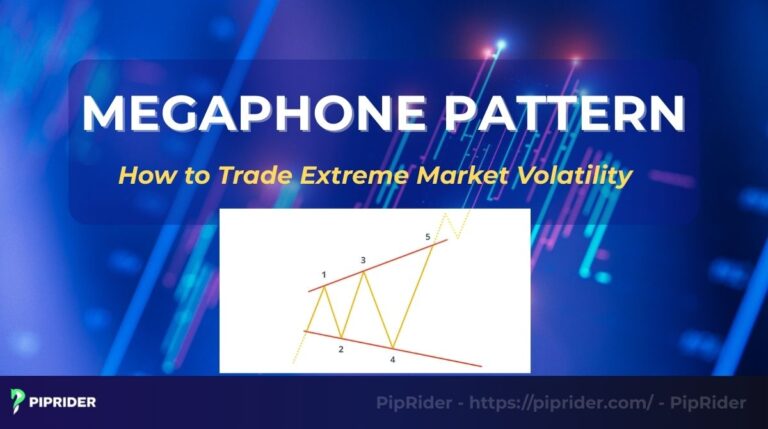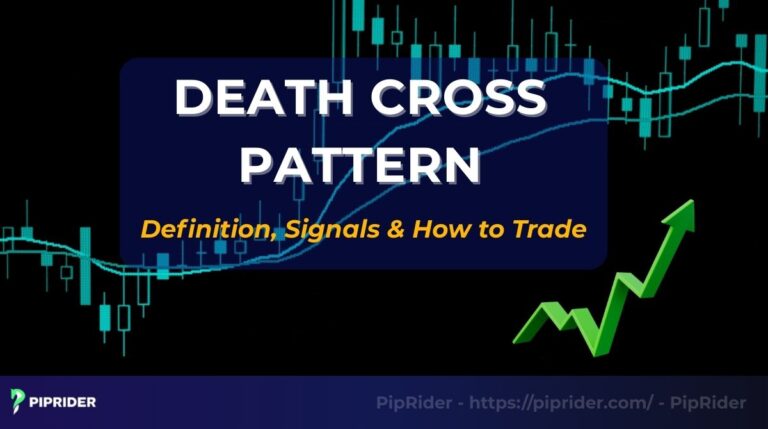The Thrusting Pattern is a high-conviction, two-candle trend continuation pattern. It signals that a minor counter-trend effort has failed to take control, as the second candle penetrates the first but fails to close past the 50% midpoint. This structural rule validates the underlying strength of the bullish or bearish continuation pattern.
This guide provides the definitive structural rules, differentiates it from the On Neckline Candlestick Pattern, and outlines precise trading strategies. This pattern is fundamental to effective technical analysis.
Key Takeaways
- A thrusting pattern is a two-candle trend continuation pattern where the second candle (C2) penetrates the body of the first (C1) but fails to close past the 50% midpoint.
- The failure to breach the 50% level confirms the original market force is dominant, validating the continuation pattern.
- Classify as Strong (shallow penetration) or Medium (deep penetration under 50%). Avoid the less reliable Reversal variant.
- Entry must be confirmed by a volume spike and alignment with major Moving Averages (MAs).
- The structural definition allows for precise, tight Stop-Loss (SL) placement, yielding a superior R:R ratio, which directly impacts trading performance.
1. What is the Thrusting Candlestick Pattern?
Much simpler than a flag pattern, the Thrusting Pattern is a two-candle continuation pattern that signals the prevailing direction is about to resume (TrendSpider Learning Center, n.d.; LiteFinance, 2025). It forms when the second candle (C2) attempts to reverse the market but fails the critical structural test: C2 must penetrate the body of the first candle (C1) but close short of the 50% midpoint. This rule applies whether the pattern is a bullish continuation pattern or a bearish continuation pattern.
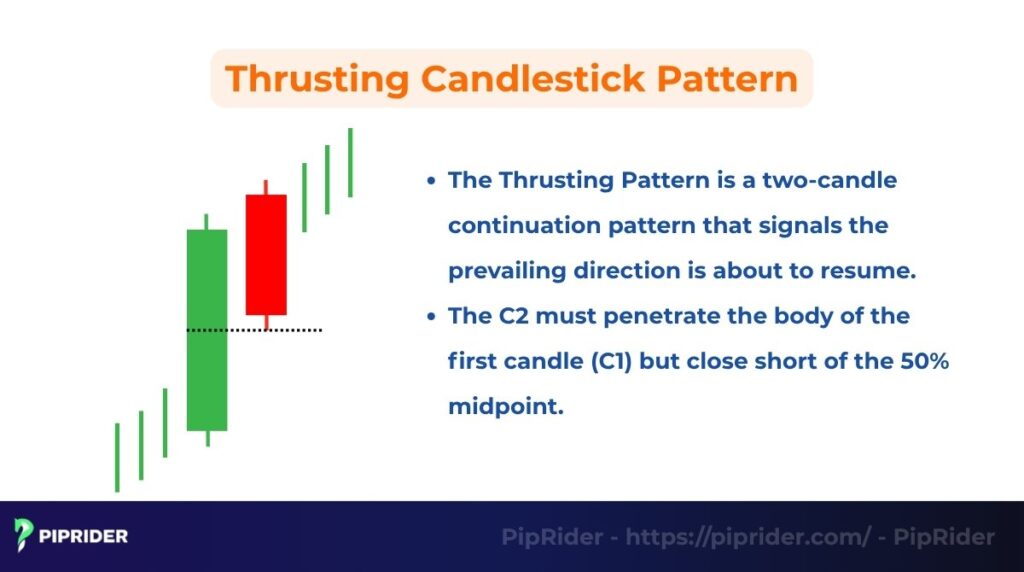
The psychology is straightforward: the failure of the opposing force to push the price past the 50% midpoint confirms they are structurally weak and the dominant market force has maintained control. This is a high-conviction price action signal that the brief pause is over and the original direction is imminent.
Thrusting Pattern vs. Other Continuation Patterns
Distinguishing the Thrusting Pattern from the other two-candle formations is critical, as a minor difference in the closing location of the second candle (C2) entirely changes the signal from Continuation to Reversal.
| Pattern | Signal Type | C2 Closing Location (vs. C1 Body) | Psychological Meaning |
| Thrusting Pattern | Continuation (Strong) | Closes below the 50% midpoint. | The dominant force maintains control, effectively absorbing the opposing pressure. |
| Piercing Line / Dark Cloud Cover | Reversal (Strong) | Closes past the 50% midpoint. | Market structure is breached; control shifts to the opposing force. |
| On Neck Line | Continuation (Weak) | Closes at or very near C1’s closing price. | The opposing force is rejected at a non-structural price level (less significant). |
2. Structure of the Thrusting Pattern
The definition of the thrusting candlestick pattern is entirely reliant on the strict relationship between two consecutive candles.
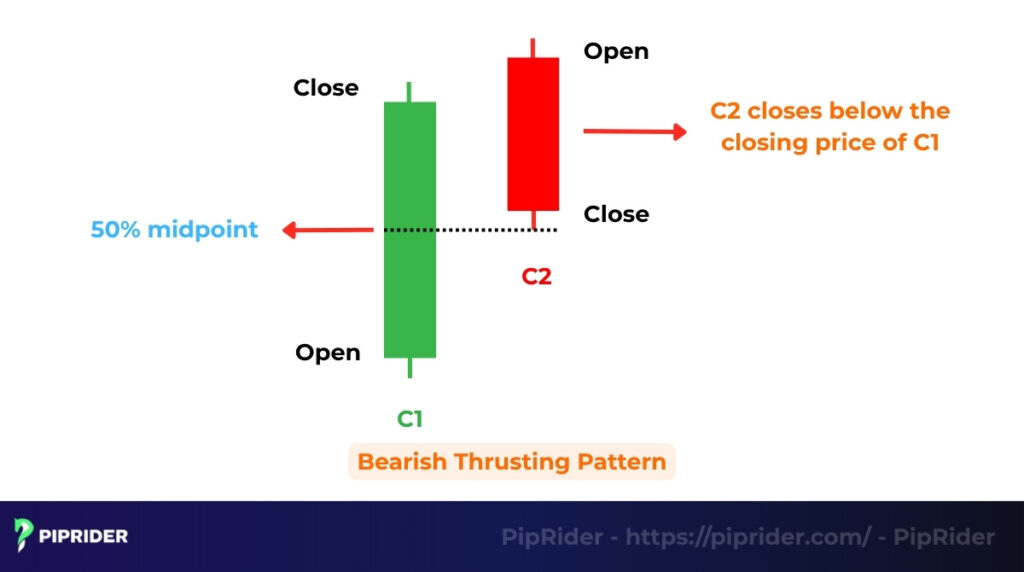
- Candle 1 (The Anchor): Must be a large, decisive candle moving strongly in the direction of the underlying trend. This candle provides the necessary range.
- Candle 2 (The Thrust): This candle attempts to move against the prevailing trend. Its closeness is the critical factor: it must penetrate the body of C1 but close short of the 50% midpoint.
As a continuation pattern, the thrusting must appear within a clear, established uptrend or downtrend. Its optimal location is mid-direction; it should appear as a pause, not directly at a major swing high or low. This confirms that the pattern is a natural stop to absorb pressure, rather than a reversal attempt against major structural levels.
Difference between Bullish Thrusting and Bearish Thrusting
The core structural rule (the 50% midpoint test) remains the same for both, but the candle colors and direction context are inverted. The detailed table clarifies the structural components and the resulting continuation pattern signal.
| Type | Preceding Trend | Candle 1 (Anchor) | Candle 2 (Thrust) | Confirmed Continuation Signal |
| Bullish Thrusting | Bearish Trend (Temporary Pullback) | Long Bearish (Red/Black) | Bullish (Green/White, Closes < 50% of C1) | Bearish Continuation (Short Trade) |
| Bearish Thrusting | Bullish Trend (Temporary Pullback) | Long Bullish (Green/White) | Bearish (Red/Black, Closes < 50% of C1) | Bullish Continuation (Long Trade) |
Note on Naming Ambiguity: The pattern name refers to the color of C2 and the preceding direction. The resulting signal is always the continuation of the original direction, as the failure of C2 to reach the 50% mark confirms the prior momentum is intact.
Read more:
Harmonic Patterns in Trading: Complete Guide with Examples
Cup And Handle Chart Pattern: Definition, Strategies & Target
3. Types of Thrusting Line Patterns
Trading strategies for continuation patterns maximize the high-probability nature of these setups. These trading techniques focus on precise execution and disciplined risk control.
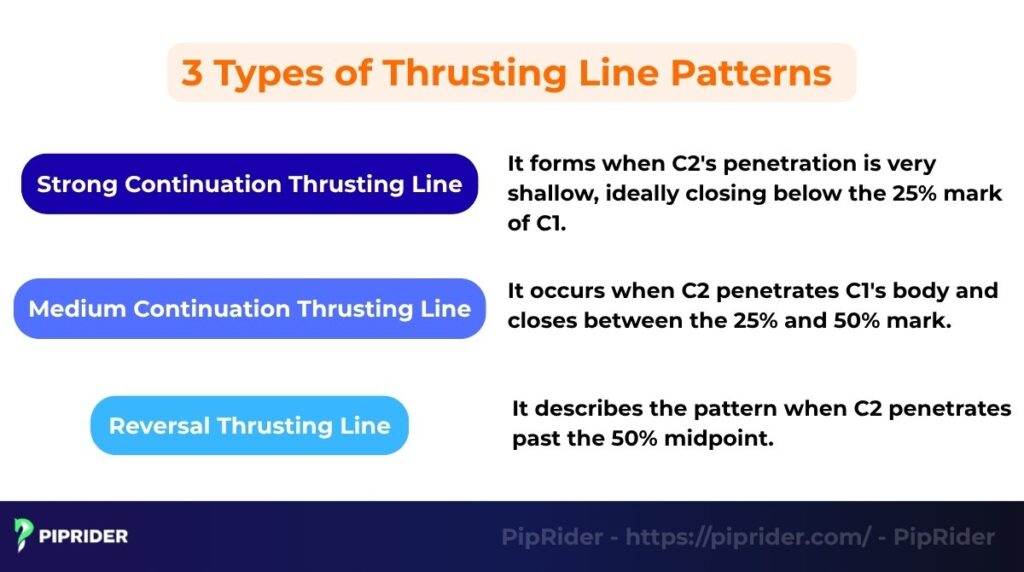
3.1. Strong Continuation Thrusting Line
The strong continuation thrusting line is the highest conviction version of the continuation pattern. It forms when C2’s penetration is very shallow, ideally closing below the 25% mark of C1. Minimal penetration signals immediate and overwhelming control by the dominant direction, offering the lowest risk and highest probability for a successful trend continuation pattern.
3.2. Medium Continuation Thrusting Line
The medium continuation thrusting line is the most common and standard variant. It occurs when C2 penetrates C1’s body and closes between the 25% and 50% mark. The deeper penetration suggests greater strength from the opposing force, meaning the setup requires stronger external confirmation from indicators (like RSI or MACD).
3.3. Reversal Thrusting Line
A reversal thrusting line represents a significant structural warning. It describes the pattern when C2 penetrates past the 50% midpoint. Caution is paramount: This structural breach technically converts the signal into a reversal pattern (Piercing Line or Dark Cloud Cover). Traders focused on continuation must generally avoid trading any pattern where the 50% rule is violated.
4. How to Identify and Confirm a Thrusting Pattern
The reliability of the thrusting pattern hinges on strict structural checks and robust external validation. This is a core part of sound technical analysis.
- Identification steps: Verify a clear direction, identify the Anchor (C1), mark its 50% midpoint, and ensure the Thrust (C2) closes short of the 50% midpoint. Wait for the third candle (C3) to break C2’s extreme and close decisively in the direction for validation.
- Indicator confirmation (MA, RSI, Volume): Validation is mandatory: Volume must spike sharply on the C3 breakout candle (after being low/decreasing on C2). The pattern must align with major MAs or a full guppy multiple moving average setup, and momentum indicators (RSI/MACD) must show no divergence.
- Common misleading signals: Beware of false breakouts caused by the two major errors:
1. C2 violating the 50% rule (which immediately signals reversal, not continuation)
2. A confirmed pattern that lacks the sharp, required volume increase on the breakout candle.
Read more:
Hikkake Pattern Explained: Complete Guide for Traders
5. Trading the Thrusting Candlestick Pattern
Trading this pattern moves beyond simple identification; it demands a precise, rule-based strategy to capitalize on the confirmed momentum and control risk. The pattern’s strict structural boundaries, particularly the C1 high/low, provide the ideal reference points for executing high-probability entries and tight stop-loss placement.

5.1. Bearish Thrusting Line Trade Setup
The bearish thrusting line occurs within a bullish trend, signaling its likely continuation downwards. The setup is designed for short positions with tightly controlled risk (TradingSim, 2016).
- Entry Points: Execute the short position immediately after the confirmation candle (C3) closes below the low of C2. This confirms sellers have regained control after the pattern formation. More aggressive traders may enter on the open of C3.
- Stop-Loss (SL) Placement: Place the SL tightly above the high of C1 (the Anchor candle). This placement uses the pattern’s structure to define the point of failure, ensuring sound risk management.
- Profit Targets (TP): Target the next major support level or use the measured move technique (projecting the height of C1 downwards from the entry). Always maintain a minimum 1:2 Risk-to-Reward (R:R) ratio.
5.2. Bullish Thrusting Line Trade Setup
The bullish thrusting line forms within a bearish trend. Although C2 is bullish, the overall signal is one of bearish continuation. The setup is designed for short positions following the original direction (TrendSpider Learning Center, n.d.).
- Entry Points: Execute the short position immediately after the confirmation candle (C3) closes below the low of C2. This is the critical moment confirming that sellers have overpowered the brief bullish thrust and resumed the downtrend.
- Stop-Loss (SL) Placement: Place the SL tightly above the high of C1 (the Anchor candle). This level defines the structural failure point for the entire pattern; if this high is breached, the continuation signal is invalid.
- Profit Targets (TP): Target the next major support level or use the measured move technique (projecting the height of C1 downwards from the entry). Always prioritize strict risk control by maintaining a minimum 1:2 Risk-to-Reward (R:R) ratio.
6. Thrusting Pattern with Trend Lines and Market Context
Context is paramount. Combining the Thrusting Candlestick Pattern with broader price action tools significantly enhances trade probability and filtering.
- Direction application: The pattern’s reliability is highest in strong, clean directions. A pattern appearing early in a direction signals robust direction continuation with fresh momentum. Conversely, if the pattern forms late in a prolonged move, it suggests directional exhaustion and requires traders to proceed with extreme caution, as it often results in reduced follow-through.
- S/R and trendlines: Use trendlines for strong directional confirmation. Crucially, traders must avoid setups where C1 or C2 forms directly into a major horizontal support & resistance (S/R) zone. These structural barriers often generate powerful counter-reactions that overwhelm continuation signals, leading to high-risk false breakouts.
- Multi-timeframe analysis: Never trade a thrusting pattern against the dominant direction established on the high timeframe (daily or H4). The HTF provides the necessary structural context. Use the Low Timeframe (H1 or M15) strictly for execution, as it allows traders to spot the pattern clearly and secure the tightest, most advantageous Stop Loss placement.
Read more:
Alligator Indicator: Best forex trading guide
7. Example Trade Using Thrusting Candlestick Pattern
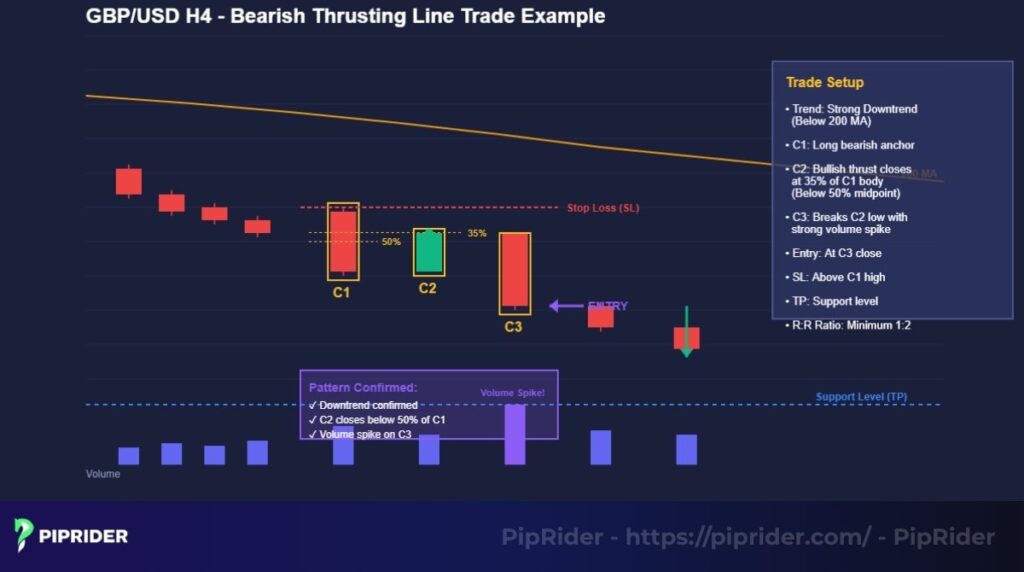
This case study illustrates a practical short trade using the Bearish Thrusting Line, focusing on the specific actions taken when the structure is confirmed. These trading examples help solidify the rules.
The trade is observed on the GBP/USD H4 chart within a strong, confirmed downtrend (price below the 200-period MA).
- C1 (The Anchor): A long bearish candle forms, confirming seller dominance.
- C2 (The Thrust): The subsequent bullish candle attempts a rally but decisively closes at the 35% mark of C1’s body, confirming the structural failure of the buyers (well below the 50% midpoint).
- C3 (Confirmation): The price breaks the low of C2 and closes sharply down. Volume spikes dramatically on this candle, providing the final, mandatory signal for entry.
Trade Execution:
- Entry Points: Execute a Short position immediately upon the close of C3.
- Stop-Loss (SL) Placement: Place the SL tightly above the high of C1. This extreme point defines the pattern’s failure boundary.
- Profit Targets (TP): Set the TP at the nearest major Support level, ensuring a minimum 1:2 Risk-to-Reward (R:R) ratio.
Results and Lessons Learned
The trade moved immediately in the direction of the original downtrend, hitting the initial profit target swiftly. The volume spike on the confirmation candle proved to be the critical factor that filtered this high-probability setup. The ability to define the stop loss precisely based on C1’s structural high allowed for exceptional risk control, capitalizing on the pattern’s verification that the buyer’s countermove had failed decisively.
8. Trading Tips for Thrusting Candlestick Pattern
Successfully trading the Thrusting Candlestick Pattern depends on discipline and strict adherence to risk rules.
- Avoiding false signals: Be stringent with the 50% midpoint rule; a violation immediately invalidates the continuation signal. Never enter without a confirmed, sharp Volume spike on the breakout candle (C3).
- Risk management (R:R Ratio): Utilize the pattern’s structure to define a tight Stop Loss (SL) just outside the high/low of C1. Always aim for a minimum 1:2 Risk-to-Reward (R:R) ratio to ensure long-term profitability.
- When NOT to trade: Avoid trading the pattern near major support & resistance levels or during non-trending, choppy ranges. These conditions often lead to false signals or volatility.
9. Pros and Cons of Thrusting Candlestick Pattern
The Thrusting Candlestick Pattern is a powerful tool, but like any technical signal, understanding its strengths and limitations is key to a robust trading strategy.

9.1. Pros
The Thrusting Pattern offers several clear structural and risk management advantages that make it highly favored by momentum traders.
- Structural clarity and simplicity: The pattern is easy to identify due to the strict visual rule: the second candle (C2) must close short of the 50% midpoint of C1.
- High reliability in trends: It provides very reliable continuation signals when observed within a strong, established directional environment.
- Precise risk management: The pattern’s clear structural boundaries (C1’s high/low) allow for exceptionally tight stop-loss placement, which significantly improves the potential risk-reward ratio.
9.2. Cons
Despite its advantages, this pattern presents inherent challenges, particularly regarding the need for external validation and market context.
- Requirement for confirmation: The pattern is not a standalone signal. It requires mandatory validation from external tools, especially Volume, to filter out whipsaws.
- Vulnerability to weak trends: It can generate numerous unreliable or false signals when the market is choppy, sideways, or within prolonged ranges.
- Need for trader experience: Effectively differentiating it from reversal patterns (like Piercing Lines) and consistently applying the strict 50% rule demands trading experience and discipline.
- Ineffectiveness during high volatility: The pattern can be instantly overridden and invalidated by sudden, high-impact news events.
10. Frequently asked questions about thrusting pattern
11. Conclusion
The Thrusting Pattern is a powerful trend continuation tool, defined by the failure of the second candle to close past the 50% midpoint of the anchor candle. This structural failure provides a high-conviction signal for momentum traders.
Success depends on strict validation and risk control. Always confirm the pattern with a sharp Volume spike on the breakout candle. Define your Stop Loss tightly using the C1 high/low and adhere to a minimum 1:2 R:R ratio. Avoid trading any pattern that violates the 50% rule or forms at major Support/Resistance.
To explore more high-probability signals, check out the Forex Chart Patterns section at Piprider.



